List of new churches by John Douglas
John Douglas (1830–1911) was an English architect based in Chester, Cheshire. His output included new churches, alterations to and restoration of existing churches, church furnishings, new houses and alterations to existing houses, and a variety of other buildings, including shops, banks, offices, schools, memorials and public buildings. Perhaps his best-known design is that for the Eastgate Clock in Chester.[1] His architectural styles were eclectic, but as he worked during the period of the Gothic Revival much of his output incorporates elements of the English Gothic style. He was also influenced by architectural styles from the mainland of Europe, and frequently included elements of French, German, and Netherlandish architecture.[2] Douglas is probably best remembered for his incorporation of vernacular elements in his buildings, in particular half-timbering,[3] in which he was influenced by the black-and-white revival in Chester.[4] Other vernacular elements he employed included tile-hanging, pargeting, and the use of decorative brick in diapering and the design of tall chimney stacks.[5] Of particular importance is Douglas' use of joinery[6] and highly detailed wood carving.[7]
.jpg.webp)
John Douglas was born in the Cheshire village of Sandiway and was articled to the Lancaster architect E. G. Paley, later becoming his chief assistant. He established an office in Chester in either 1855 or 1860, from where he practised throughout his career.[1] Initially he ran the office himself but in 1884 he appointed his assistant, Daniel Porter Fordham, as a partner. When Fordham retired in 1897, he was succeeded by Charles Howard Minshull. In 1909 this partnership was dissolved and Douglas ran the office alone until his death in 1911.[8] As his office was in Chester, most of his works were in Cheshire and North Wales, although some were further afield, in Lancashire, Staffordshire, Warwickshire, and Scotland.[9]
From an early stage in his career, Douglas attracted commissions from wealthy and powerful patrons, the first of which came from Hugh Cholmondeley, 2nd Baron Delamere. His most important patrons were the Grosvenor family of Eaton Hall, namely Richard Grosvenor, 2nd Marquess of Westminster, Hugh Grosvenor, 1st Duke of Westminster, and Hugh Grosvenor, 2nd Duke of Westminster. Douglas designed a large number and variety of buildings in the family's Eaton Hall estate and the surrounding villages. Other important patrons were William Molyneux, 4th Earl of Sefton, Rowland Egerton-Warburton of Arley Hall, George Cholmondeley, 5th Marquess of Cholmondeley, and Francis Egerton, 3rd Earl of Ellesmere. Later in his career Douglas carried out commissions for W. E. Gladstone and his family, and for W. H.Lever.
Most of Douglas' new churches have been recognised as listed buildings. In England and Wales a Grade I listed building is one "of exceptional interest, sometimes considered to be internationally important", Grade II* consists of "particularly important buildings of more than special interest", and in Grade II are buildings which "are nationally important and of special interest".[10] In Scotland, Category A contains "buildings of national or international importance, either architectural or historic, or fine little-altered examples of some particular period, style or building type", Category B consists of "buildings of regional or more than local importance, or major examples of some particular period, style or building type which may have been altered", and in Category C are "buildings of local importance, lesser examples of any period, style, or building type, as originally constructed or moderately altered; and simple traditional buildings which group well with others in categories A and B".[11]
This list includes the 40 new churches designed by Douglas that were built. The details are taken from the Catalogue of Works in the biography by Edward Hubbard.[9] Churches attributed to Douglas by Hubbard on stylistic grounds together with evidence of a local association are included, even though they are not confirmed by other reliable evidence.[12] Where this is the case, it is stated in the Notes column. Unexecuted schemes are not included.
Key
| Grade | Criteria[10] | ||||||||||||
|---|---|---|---|---|---|---|---|---|---|---|---|---|---|
| Grade I | Buildings of exceptional interest, sometimes considered to be internationally important. | ||||||||||||
| Grade II* | Particularly important buildings of more than special interest. | ||||||||||||
| Grade II | Buildings of national importance and special interest. | ||||||||||||
| Category (Scotland) | Criteria[11] | ||||||||||||
| B | Buildings of special architectural or historic interest which are major examples of a particular period, style or building type. | ||||||||||||
| "—" denotes a work that is not graded. | |||||||||||||
New churches
| Name | Location | Photograph | Date | Notes | Grade |
|---|---|---|---|---|---|
| St John the Evangelist's Church | Over, Winsford, Cheshire 53.1922°N 2.5481°W |
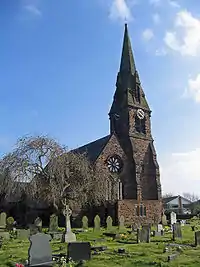 |
1860–63 | This was Douglas' first church and was designed as a memorial to the first wife of the 2nd Baron Delamere. It is in Gothic Revival style.[13][14] | II[15] |
| Congregational Chapel | Over, Winsford, Cheshire 53.1883°N 2.5399°W |
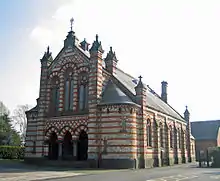 |
1865 | This church is built in polychromatic brick with some red sandstone dressings. Pevsner describes it as being "very ugly" while Hubbard describes it as being "experimental" and presenting "an astonishing sight". It is now a United Reformed church.[16][17] | II[18] |
| St John the Baptist's Church | Aldford, Cheshire 53.1290°N 2.8698°W |
 |
1. 1865–66 2. c.1872–76 3. 1902 |
St John's was the first church commissioned by the Grosvenor family 1. A new church was built on the site of an earlier church. 2. Additions were made including a spire and a reredos. 3. A vestry was converted into a chapel and another vestry was added.[19][20] |
II[21] |
| St Bartholomew's Church | Sealand, Flintshire 53.2128°N 2.9709°W |
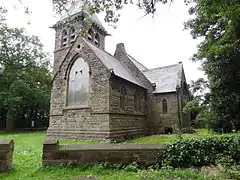 |
1865–67 | This is a small church designed for the River Dee Company in Early Decorated style. Douglas paid for the stained glass by Hardman & Co. in the east window.[22][23] | II[24] |
| St Ann's Church | Warrington, Cheshire 53.3967°N 2.5947°W |
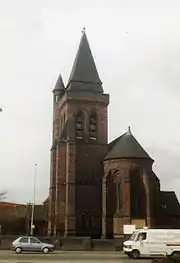 |
1868–69 | The church is in bold High Victorian style with a broad aisleless nave. It is now redundant and has been used as an indoor climbing centre since 1996.[25][26] | II*[27] |
| St Paul's Church | Helsby, Cheshire 53.2775°N 2.7612°W |
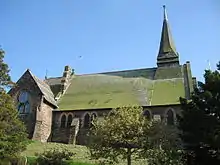 |
1. 1868–70 2. 1909 |
1. This is a small church with a western bell-turret in the form of a flèche. 2. A south aisle was added.[28][29] |
II[30] |
| St John the Baptist's Church | Hartford, Cheshire 53.2458°N 2.5441°W |
 |
1. 1873–75 2. 1885–87 |
1. A new church was built on the site of an older church. 2. A tower was added at the west end.[31][32] |
II[33] |
| St Paul's Church | Marston, Cheshire 53.275°N 2.496°W |
— |
1874 | This was a small church with much moulded brick, lancet windows, a small west tower and spire. It has been demolished.[34] | — |
| Presbyterian Chapel | Rossett, Wrexham County Borough 53.1076°N 2.9524°W |
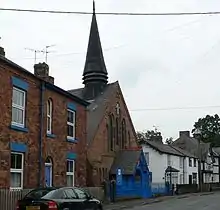 |
1875 | This is a church with lancet windows, a timber porch and a flèche.[35][36] | — |
| Christ Church | Gloucester Street, Chester, Cheshire 53.1969°N 2.8885°W |
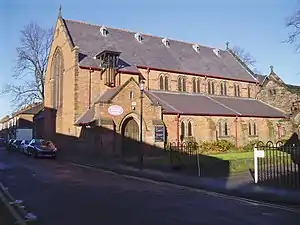 |
1. 1876 2. 1893 3. 1897 4. 1898 5. 1900 |
1. A new church was built to replace a previous one on the site. 2–5. During these years a new sanctuary was added, then the porch, the pulpit and the southeast chapel. Later the vestry and organ chamber were added, work was done on the chancel, and the nave was completed.[37][38] |
II[39] |
| St Stephen's Church | Moulton, Cheshire 53.2227°N 2.5168°W |
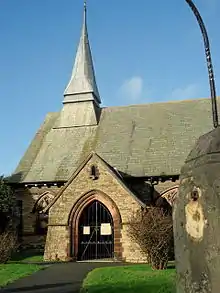 |
1876–77 | The exterior of this church is built in stone while the interior is in two kinds of brick. It has a green slate roof and a lead spire.[40][41] | II[42] |
| St Barnabas' Mission Church and Curate's House | Sibell Street, Chester, Cheshire 53.1967°N 2.8828°W |
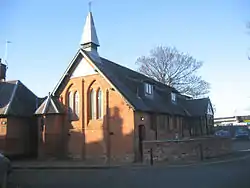 |
1877 | The church was built a mission church with an adjacent house for the curate, It is now used as offices.[43] | II[44] |
| Church of St Mary the Virgin | Halkyn, Flintshire 53.2316°N 3.1862°W |
 |
1877–88 | The church was built for the 1st Duke of Westminster. Hubbard considers it to be "one of the best Victorian churches in Clwyd" which "sets the tone for virtually all his [Douglas'] subsequent churches".[45][46] | I[47] |
| St Michael's Church | Altcar, Lancashire 53.5509°N 3.0283°W |
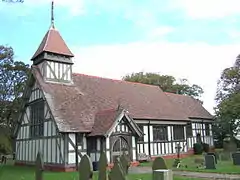 |
1878–79 | This church was designed for the 4th Earl of Sefton and is unique in Douglas' output in being entirely half-timbered. In the Buildings of England series it is described as "an utterly charming church".[48][49] | II*[50] |
| Welsh Church of St John the Evangelist | Mold, Flintshire 53.1686°N 3.1410°W |
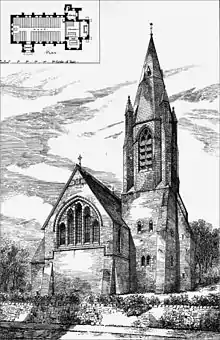 |
1878–79 | This church is broad without aisles but is now redundant. It has been divided and is used as a church hall.[51][52] | II[53] |
| Grosvenor Park Baptist Chapel | Grosvenor Road, Chester, Cheshire 53.19169°N 2.88192°W |
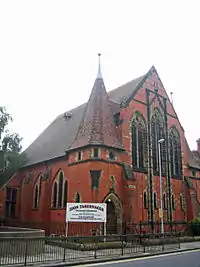 |
1879–80 | This was built in association with a terrace of houses in the same road. It was originally a Baptist chapel but is now known as Zion Tabernacle.[54][55] | II[56] |
| St Chad's Church | Hopwas, Staffordshire 52.6433°N 1.7418°W |
 |
1881 | The church was built for Rev W. MacGregor. It is in brick and half-timber with a timber-framed porch and has an octagonal flèche.[57] | II[58] |
| St Mary's Church | Pulford, Cheshire 53.1224°N 2.9348°W |
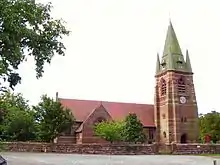 |
1881–84 | The church was built for the 1st Duke of Westminster in red sandstone with bands of lighter stone. It is cruciform in plan with a northwest tower which incorporates the porch.[59][60] | II*[61] |
| St Werburgh's New Church | Warburton, Greater Manchester 53.3984°N 2.4454°W |
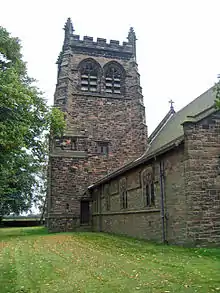 |
1. 1882–85 2. 1899 |
1. This was a new church built for Rowland Egerton-Warburton in sandstone to replace St Werburgh's Old Church but on a different site. 2. The chancel stalls were replaced.[62][63] |
II[64] |
| Holywell Workhouse Chapel | Holywell, Flintshire 53.2663°N 3.2168°W |
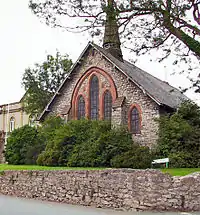 |
1883–84 | A chapel with a shingled flèche for the workhouse which later became Lluesty Hospital.[65][66] | II[67] |
| Chapel of the Good Shepherd | Carlett Park, Eastham, Merseyside 53.3230°N 2.9593°W |
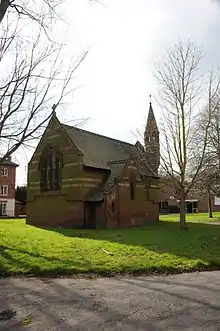 |
1884–85 | This was a family chapel for Rev W. E. Torr who lived at the manor house. It is a simple building in stone with lancet windows and a northwest turret.[68][69][70] | II[71] |
| St Deiniol's Church | Criccieth, Gwynedd 52.9202°N 4.2310°W |
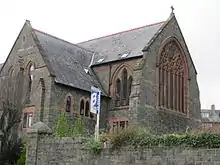 |
1884–87 | This was a cruciform church with a short spire. It closed in 1988 and has been converted into residential flats.[68] | — |
| Christ Church | Rossett, Wrexham County Borough 53.1078°N 2.9490°W |
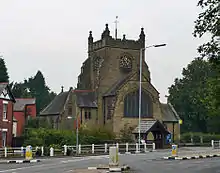 |
1886–92 | This is a church built to replace an earlier church in the site. It is cruciform in plan and built in stone with a green slate roof. It was planned in 1886 but not built until 1891–92.[72][73] | II[74] |
| St Paul's Church | Colwyn Bay, Conwy County Borough 53.2939°N 3.7265°W |
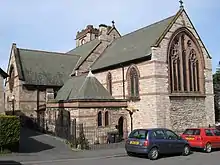 |
1. 1887–88 2. 1894–95 3. 1910–11 |
The church was built in three stages. 1. In the first stage the nave was built. 2. The chancel was built. 3. The tower was added.[75][76] |
II*[77] |
| St Andrew's Church | West Kirby, Merseyside 53.3761°N 3.1858°W |
— |
1. 1889–91 2. 1907 |
The church was built in two stages: 1. The nave was built. 2. The church was completed.[78][79] |
II[80] |
| St John's Church | Barmouth, Gwynedd 52.7233°N 4.0548°W |
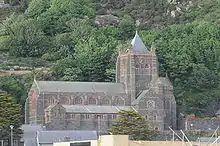 |
1889–95 | This church was built for Mrs. F. S. Perrins and is set on a hillside overlooking the town. During its construction the tower collapsed and had to be rebuilt.[81] | II*[82] |
| St James' Church | Haydock, Merseyside 53.4678°N 2.6595°W |
— |
c. 1891–92 | The church incorporated part of the previous church as a Lady chapel. It was built with timber framing to give protection against possible mining subsidence.[83][84] | — |
| St Wenefrede's Church | Bickley, Cheshire 53.0364°N 2.6922°W |
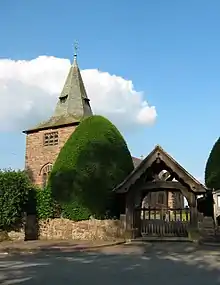 |
1892 | The church was built for the 4th Marquess of Cholmondeley in sandstone with a roof of green slates and terracotta ridge tiles. Inside the church is a hammerbeam roof.[85][86] | II[87] |
| St David's Welsh Church | Rhosllannerchrugog, Wrexham County Borough 53.0115°N 3.0569°W |
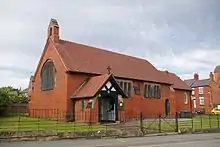 |
1892–93 | Douglas & Fordham designed a church with a nave and a north aisle. The chancel was added later. It was intended to have a northeast steeple, but this was never built.[88][89] | — |
| All Saints Church | Higher Kinnerton, Flintshire 53.1439°N 3.0044°W |
 |
1893 | The church has a central spire, and another smaller spire above the chancel.[90][91] | — |
| Christ Church | Bryn-y-Maen, Colwyn Bay, Conwy County Borough 53.2695°N 3.7465°W |
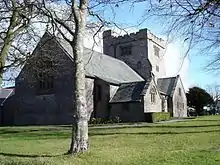 |
1896–99 | The church was built in memory of Eleanor Frost's husband, Charles, in a small village to the south of Colwyn Bay. It is known locally as the "Cathedral of the Hills".[92][93] | II*[94] |
| Congregational Church | Great Crosby, Merseyside 53.4914°N 3.0250°W |
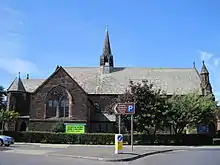 |
1897–98 | The church is built in sandstone with green slate roofs. Originally a Congregational church, it is now a United Reformed Church.[95] | II[96] |
| St John the Evangelist's Church | Weston, Runcorn, Cheshire 53.3190°N 2.73885°W |
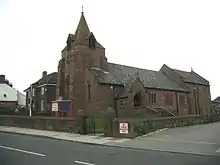 |
1. 1897–98 2. 1900 |
It is known as the "choirboys' church", because the choirboys wrote thousands of letters to raise money for it. 1. The church was built. 2. The tower was added.[97][98][99] |
II*[100] |
| All Saints Church | Deganwy, Conwy County Borough 53.2941°N 3.8270°W |
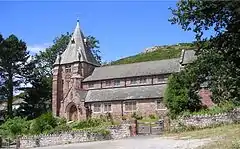 |
1897–99 | This is a memorial church built for Lady Augusta Mostyn on a site overlooking the Conwy estuary. It has a clerestory, a chancel higher than the nave and a west tower.[101] | II*[102] |
| St Ethelwold's Church | Shotton, Flintshire 53.2096°N 3.0346°W |
— |
1898–1902 | Although the church was partly financed by W. E. Gladstone, its building did not start until after his death.[23][103] | II[104] |
| St John the Baptist's Church | Old Colwyn, Conwy County Borough 53.2906°N 3.6974°W |
— |
1. 1899–1903 2. 1912 |
The church was built for the English-speaking community of Colwyn Bay. 1. The church was built. 2. The tower was added (after Douglas' death).[105][106] |
II*[107] |
| St David's Welsh Church | Colwyn Bay, Conwy County Borough 53.2937°N 3.7268°W |
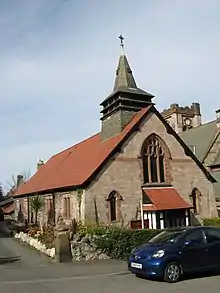 |
1902–03 | The church was built close to St Paul's Church to serve the Welsh-speaking community.[108][109] | II[110] |
| St John the Evangelist's Church | Sandiway, Cheshire 53.2359°N 2.5921°W |
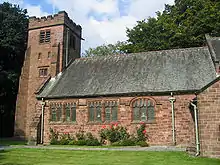 |
1. 1902–03 2. Undated |
1. The church was built on land owned by Douglas who also paid for the chancel and lych gate. 2. The tower was added after Douglas' death.[111][112] |
II[113] |
| All Saints Church | Lockerbie, Dumfries and Galloway 55.124°N 3.361°W |
 |
1903 | This is Douglas' only Scottish Episcopal Church. It is built in ashlar stone with a red tile roof and has a west tower with a broach spire.[114] | B[115] |
| Congregational Church | Hoylake, Merseyside 53.3900°N 3.1805°W |
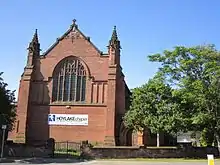 |
1905–06 | Built in brick with sandstone dressings, it is in Perpendicular style. It originally had a spire, but this sustained war damage, and has not been replaced.[116] | II[117] |
| St Matthew's Church | Saltney, Flintshire 53.183°N 2.947°W |
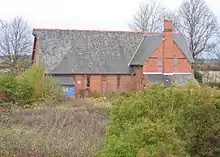 |
1910–11 | This was a mission church to St Mark's Church, Saltney. It was closed in 2000 and destroyed by fire in 2008.[118][119] | — |
See also
| Wikimedia Commons has media related to John Douglas (architect). |
References
Citations
- Howell, Peter (2004) 'Douglas, John (1830-1911)', Oxford Dictionary of National Biography, Oxford University Press , retrieved 22 January 2008 (subscription or UK public library membership required)
- John Douglas, Dictionary of Scottish Architects, retrieved 19 December 2016
- Hubbard 1991, p. 95.
- Hartwell et al. 2011, pp. 56–57.
- Hubbard 1991, pp. 77–80.
- Hubbard 1991, pp. 84–87.
- Hubbard 1991, pp. 189–190.
- Hubbard 1991, pp. 6–7.
- Hubbard 1991, pp. 238–279.
- Listed Buildings, Historic England, retrieved 29 March 2015
- What is Listing?: Categories of listed building, Historic Environment Scotland, retrieved 4 July 2020
- Hubbard 1991, p. 238.
- Hubbard 1991, pp. 27, 238.
- Hartwell et al. 2011, p. 680.
- Historic England, "Church of St John the Evangelist, Winsford (1329818)", National Heritage List for England, retrieved 29 March 2015
- Hartwell et al. 2011, pp. 680–681.
- Hubbard 1991, pp. 43–44, 229.
- Historic England, "The Congregational Church, Winsford (1160821)", National Heritage List for England, retrieved 29 March 2015
- Hubbard 1991, pp. 48, 239, 244, 273.
- Hartwell et al. 2011, pp. 94–95.
- Historic England, "Church of St John the Baptist, Aldford (1135984)", National Heritage List for England, retrieved 29 March 2015
- Hubbard 1991, pp. 48–50, 239.
- Hubbard 1986, p. 420.
- Cadw, "Church of St Bartholomew (62)", National Historic Assets of Wales, retrieved 4 July 2020
- Hubbard 1991, pp. 55–57, 240.
- Pollard & Pevsner 2006, p. 621.
- Historic England, "Church of St Ann, Warrington (1161591)", National Heritage List for England, retrieved 29 March 2015
- Hubbard 1991, pp. 54–55, 203, 240, 276.
- Hartwell et al. 2011, p. 394.
- Historic England, "Church of St Paul, Helsby (1253457)", National Heritage List for England, retrieved 29 March 2015
- Hubbard 1991, pp. 130–131, 244, 255.
- Hartwell et al. 2011, p. 390.
- Historic England, "Church of St John, Hartford (1228363)", National Heritage List for England, retrieved 29 March 2015
- Hubbard 1991, pp. 131, 245.
- Hubbard 1991, pp. 131, 246.
- Hubbard 1986, p. 267.
- Hubbard 1991, pp. 131, 246–247, 262–263, 268, 269, 271–272.
- Hartwell et al. 2011, pp. 240–241.
- Historic England, "Christ Church, Chester (1375936)", National Heritage List for England, retrieved 29 March 2015
- Hubbard 1991, pp. 131, 247.
- Hartwell et al. 2011, pp. 489–490.
- Historic England, "Church of St Stephen, Moulton (1310471)", National Heritage List for England, retrieved 29 March 2015
- Hubbard 1991, p. 247.
- Historic England, "Former Church of St Barnabas and Curate's House, Chester (1375935)", National Heritage List for England, retrieved 29 March 2015
- Hubbard 1991, pp. 134–137, 248.
- Hubbard 1986, pp. 359–360.
- Cadw, "Church of St Mary, Halkin (542)", National Historic Assets of Wales, retrieved 4 July 2020
- Hubbard 1991, pp. 126–127, 249.
- Pollard & Pevsner 2006, pp. 179–180.
- Historic England, "Church of St Michael, Great Altcar (1230934)", National Heritage List for England, retrieved 29 March 2015
- Hubbard 1991, pp. 173–174, 249.
- Hubbard 1986, p. 392.
- Cadw, "Church Hall, Mold (388)", National Historic Assets of Wales, retrieved 4 July 2020
- Hubbard 1991, pp. 114, 249–250.
- Protestant Nonconformity, British History Online, retrieved 14 March 2008
- Historic England, "Zion Chapel, Chester (1375836)", National Heritage List for England, retrieved 29 March 2015
- Hubbard 1991, pp. 127, 251.
- Historic England, "Church of St Chad, Wigginton and Hopwas (1038801)", National Heritage List for England, retrieved 29 March 2015
- Hubbard 1991, pp. 137, 252.
- Hartwell et al. 2011, p. 549.
- Historic England, "Church of St Mary, Pulford (1138390)", National Heritage List for England, retrieved 29 March 2015
- Hubbard 1991, pp. 137–139, 253, 271.
- Hartwell et al. 2011, p. 656.
- Historic England, "Church of St Werburg, Warburton (1347816)", National Heritage List for England, retrieved 29 March 2015
- Hubbard 1991, p. 253.
- Hubbard 1986, pp. 374–375.
- Cadw, "Former Chapel at Lluesty Hospital (455)", National Historic Assets of Wales, retrieved 4 July 2020
- Hubbard 1991, pp. 173, 254.
- Hartwell et al. 2011, p. 344.
- History of Eastham, Sunnyfield, archived from the original on 5 May 2009, retrieved 10 June 2009
- Historic England, "Chapel at Carlett Park Technical College (1184843)", National Heritage List for England, retrieved 29 March 2015
- Hubbard 1991, pp. 173–175, 256.
- Hubbard 1986, pp. 266–267.
- Cadw, "Christ Church, Rossett (17453)", National Historic Assets of Wales, retrieved 4 July 2020
- Hubbard 1991, pp. 175–176, 257, 264, 276.
- Hubbard 1986, pp. 135–136.
- Cadw, "Church of St Paul, Colwyn Bay (14657)", National Historic Assets of Wales, retrieved 4 July 2020
- Hubbard 1991, pp. 176–177, 259, 275–276.
- Hartwell et al. 2011, p. 662.
- Historic England, "Church of St Andrew, Hoylake (1242750)", National Heritage List for England, retrieved 29 March 2015
- Hubbard 1991, pp. 177–179, 259.
- Cadw, "Church of St John, Barmouth (15467)", National Historic Assets of Wales, retrieved 4 July 2020
- Hubbard 1991, pp. 181–182, 261.
- Pollard & Pevsner 2006, pp. 195–196.
- Hubbard 1991, pp. 182–183, 261.
- Hartwell et al. 2011, p. 130.
- Historic England, "Church of St Wenefrede, Bickley (1130617)", National Heritage List for England, retrieved 29 March 2015
- Hubbard 1991, p. 262.
- Hubbard 1986, p. 264.
- Hubbard 1991, p. 263.
- Hubbard 1986, p. 371.
- Hubbard 1991, pp. 179–180, 186, 267.
- Hubbard 1986, pp. 113–114.
- Cadw, "Christ Church, Bryn-y-Maen (14722)", National Historic Assets of Wales, retrieved 4 July 2020
- Hubbard 1991, pp. 184, 268.
- Historic England, "Crosby United Reformed Church (1257394)", National Heritage List for England, retrieved 29 March 2015
- Hubbard 1991, pp. 183–184, 268.
- Hartwell et al. 2011, pp. 664–665.
- Cowan, Alex (2008), St. John the Evangelist Church, Weston, Runcorn, Weston: Les Littlemore, p. 2
- Historic England, "Parish Church of St John the Evangelist, Runcorn (1130422)", National Heritage List for England, retrieved 29 March 2015
- Hubbard 1991, pp. 181–182, 268–269.
- Cadw, "All Saints Church, Deganwy (3635)", National Historic Assets of Wales, retrieved 4 July 2020
- Hubbard 1991, p. 270.
- Cadw, "Church of St Ethelwold (60)", National Historic Assets of Wales, retrieved 4 July 2020
- Hubbard 1991, pp. 271, 277.
- Hubbard 1986, p. 257.
- Cadw, "Church of St John, Old Colwyn (14863)", National Historic Assets of Wales, retrieved 4 July 2020
- Hubbard 1991, p. 273.
- Hubbard 1986, p. 135.
- Cadw, "Church of St David, Colwyn Bay (14708)", National Historic Assets of Wales, retrieved 4 July 2020
- Hubbard 1991, pp. 194–195, 273, 279.
- Hartwell et al. 2011, pp. 580–581.
- Historic England, "Church of St John the Evangelist, Cuddington (1287518)", National Heritage List for England, retrieved 29 March 2015
- Hubbard 1991, p. 274.
- Historic Environment Scotland, "Ashgrove Terrace, All Saints Episcopal Church (Category B Listed Building) (LB37558)", retrieved 20 March 2019
- Hartwell et al. 2011, p. 406.
- Historic England, "United Reformed Church, Hoylake (1258515)", National Heritage List for England, retrieved 29 March 2015
- Hubbard 1991, pp. 202, 276.
- Hubbard 1986, p. 443.
Sources
- Hartwell, Clare; Hyde, Matthew; Hubbard, Edward; Pevsner, Nikolaus (2011) [1971], Cheshire, The Buildings of England, New Haven and London: Yale University Press, ISBN 978-0-300-17043-6
- Hubbard, Edward (1986), The Buildings of Wales: Clwyd, London: Penguin, ISBN 0-14-071052-3
- Hubbard, Edward (1991), The Work of John Douglas, London: The Victorian Society, ISBN 0-901657-16-6
- Pollard, Richard; Pevsner, Nikolaus (2006), Lancashire: Liverpool and the South-West, The Buildings of England, New Haven and London: Yale University Press, ISBN 0-300-10910-5